Organisational Analysis Portfolio: Strategic Framework & Performance
VerifiedAdded on 2023/06/15
|38
|10622
|152
Portfolio
AI Summary
This portfolio presents a comprehensive analysis of various organizational concepts through a selection of answered questions. It begins with an introduction summarizing the organizations under study, including IKEA for external analysis focusing on its cultural adaptation, Nokia for internal analysis highlighting its technological challenges, Amazon for its e-commerce success, and Royal Dutch Shell for its strategic scenario planning. The portfolio covers fundamental aspects of organizations, strategic decision-making, and the application of frameworks like PESTLE, Porter's Five Forces, McKinsey 7S, and the Balanced Scorecard. Each section delves into specific areas such as external and internal environments, competitive advantage, stakeholder analysis, and performance management, providing detailed insights and real-world examples to illustrate key concepts. The conclusion synthesizes the research, offering a holistic view of organizational dynamics and strategic management.
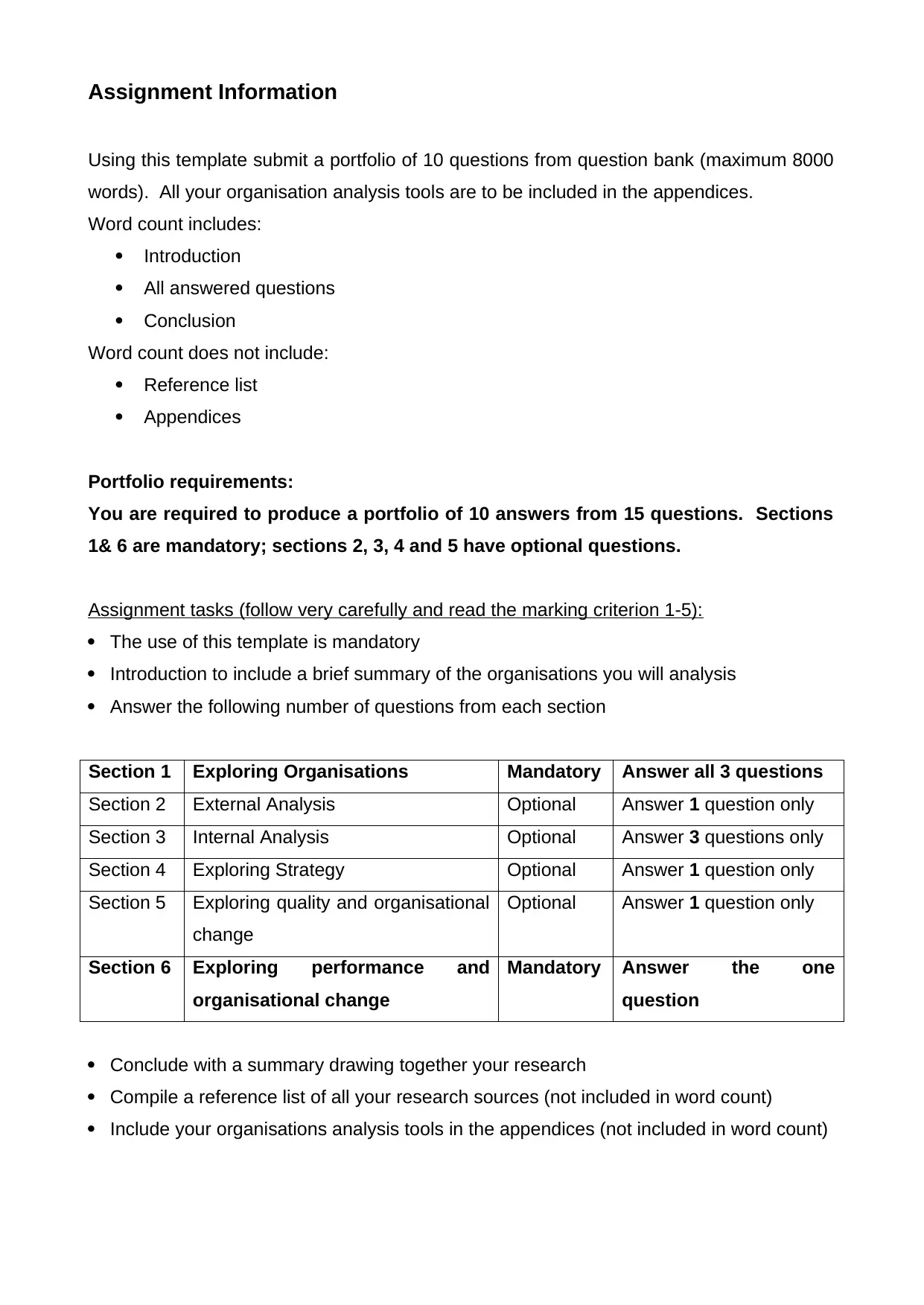
Assignment Information
Using this template submit a portfolio of 10 questions from question bank (maximum 8000
words). All your organisation analysis tools are to be included in the appendices.
Word count includes:
Introduction
All answered questions
Conclusion
Word count does not include:
Reference list
Appendices
Portfolio requirements:
You are required to produce a portfolio of 10 answers from 15 questions. Sections
1& 6 are mandatory; sections 2, 3, 4 and 5 have optional questions.
Assignment tasks (follow very carefully and read the marking criterion 1-5):
The use of this template is mandatory
Introduction to include a brief summary of the organisations you will analysis
Answer the following number of questions from each section
Section 1 Exploring Organisations Mandatory Answer all 3 questions
Section 2 External Analysis Optional Answer 1 question only
Section 3 Internal Analysis Optional Answer 3 questions only
Section 4 Exploring Strategy Optional Answer 1 question only
Section 5 Exploring quality and organisational
change
Optional Answer 1 question only
Section 6 Exploring performance and
organisational change
Mandatory Answer the one
question
Conclude with a summary drawing together your research
Compile a reference list of all your research sources (not included in word count)
Include your organisations analysis tools in the appendices (not included in word count)
Using this template submit a portfolio of 10 questions from question bank (maximum 8000
words). All your organisation analysis tools are to be included in the appendices.
Word count includes:
Introduction
All answered questions
Conclusion
Word count does not include:
Reference list
Appendices
Portfolio requirements:
You are required to produce a portfolio of 10 answers from 15 questions. Sections
1& 6 are mandatory; sections 2, 3, 4 and 5 have optional questions.
Assignment tasks (follow very carefully and read the marking criterion 1-5):
The use of this template is mandatory
Introduction to include a brief summary of the organisations you will analysis
Answer the following number of questions from each section
Section 1 Exploring Organisations Mandatory Answer all 3 questions
Section 2 External Analysis Optional Answer 1 question only
Section 3 Internal Analysis Optional Answer 3 questions only
Section 4 Exploring Strategy Optional Answer 1 question only
Section 5 Exploring quality and organisational
change
Optional Answer 1 question only
Section 6 Exploring performance and
organisational change
Mandatory Answer the one
question
Conclude with a summary drawing together your research
Compile a reference list of all your research sources (not included in word count)
Include your organisations analysis tools in the appendices (not included in word count)
Paraphrase This Document
Need a fresh take? Get an instant paraphrase of this document with our AI Paraphraser
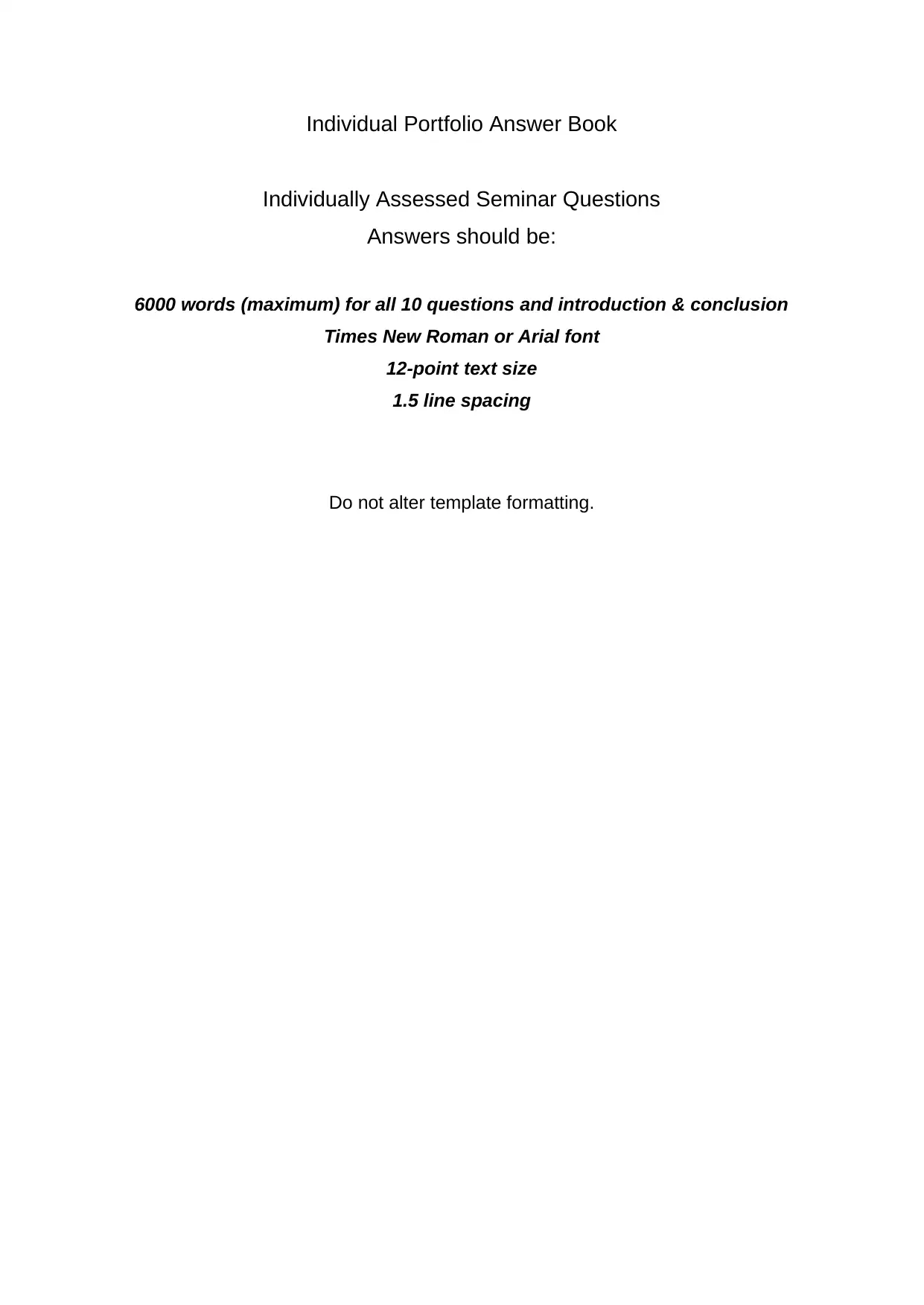
Individual Portfolio Answer Book
Individually Assessed Seminar Questions
Answers should be:
6000 words (maximum) for all 10 questions and introduction & conclusion
Times New Roman or Arial font
12-point text size
1.5 line spacing
Do not alter template formatting.
Individually Assessed Seminar Questions
Answers should be:
6000 words (maximum) for all 10 questions and introduction & conclusion
Times New Roman or Arial font
12-point text size
1.5 line spacing
Do not alter template formatting.
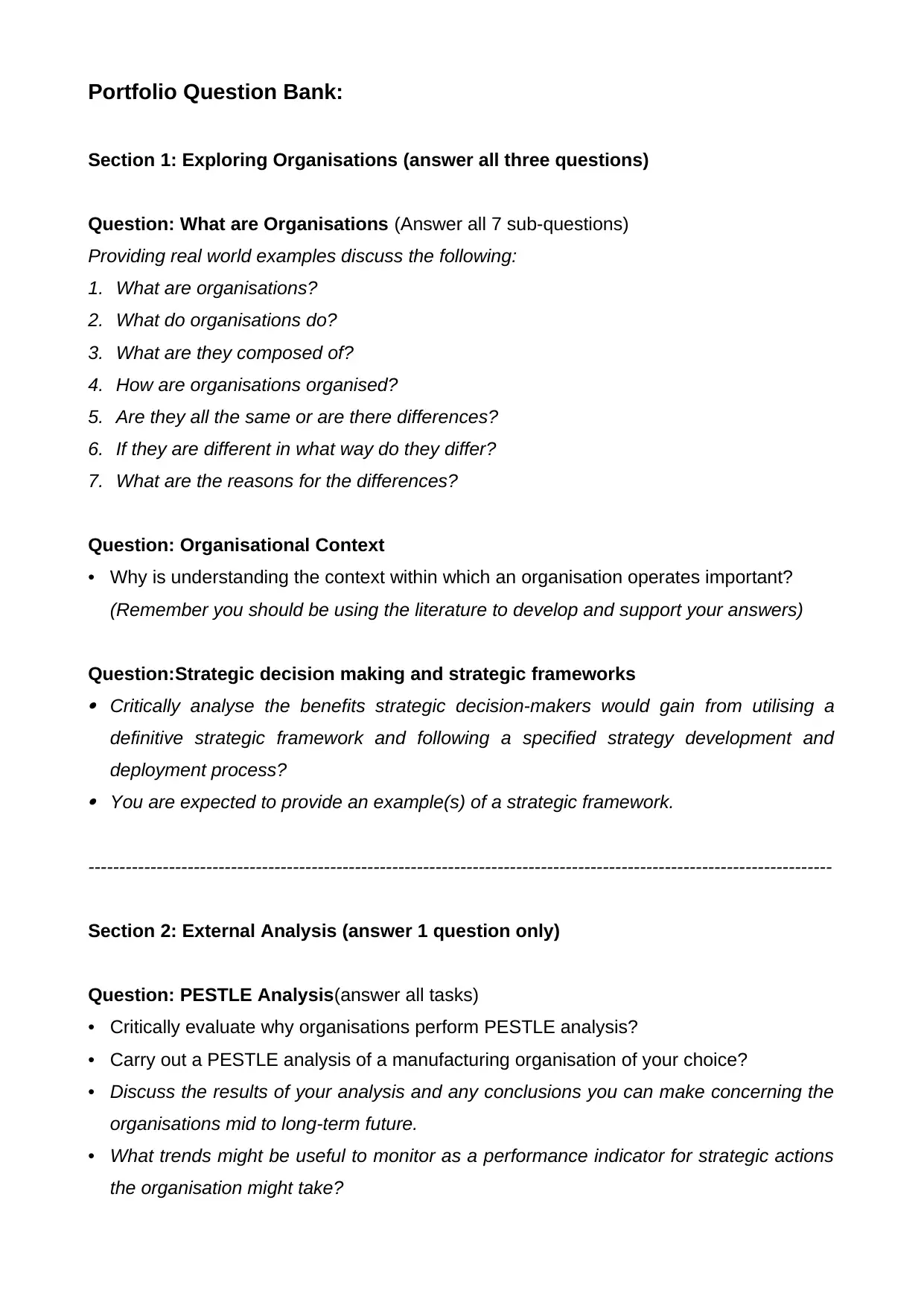
Portfolio Question Bank:
Section 1: Exploring Organisations (answer all three questions)
Question: What are Organisations (Answer all 7 sub-questions)
Providing real world examples discuss the following:
1. What are organisations?
2. What do organisations do?
3. What are they composed of?
4. How are organisations organised?
5. Are they all the same or are there differences?
6. If they are different in what way do they differ?
7. What are the reasons for the differences?
Question: Organisational Context
• Why is understanding the context within which an organisation operates important?
(Remember you should be using the literature to develop and support your answers)
Question:Strategic decision making and strategic frameworks Critically analyse the benefits strategic decision-makers would gain from utilising a
definitive strategic framework and following a specified strategy development and
deployment process? You are expected to provide an example(s) of a strategic framework.
------------------------------------------------------------------------------------------------------------------------
Section 2: External Analysis (answer 1 question only)
Question: PESTLE Analysis(answer all tasks)
• Critically evaluate why organisations perform PESTLE analysis?
• Carry out a PESTLE analysis of a manufacturing organisation of your choice?
• Discuss the results of your analysis and any conclusions you can make concerning the
organisations mid to long-term future.
• What trends might be useful to monitor as a performance indicator for strategic actions
the organisation might take?
Section 1: Exploring Organisations (answer all three questions)
Question: What are Organisations (Answer all 7 sub-questions)
Providing real world examples discuss the following:
1. What are organisations?
2. What do organisations do?
3. What are they composed of?
4. How are organisations organised?
5. Are they all the same or are there differences?
6. If they are different in what way do they differ?
7. What are the reasons for the differences?
Question: Organisational Context
• Why is understanding the context within which an organisation operates important?
(Remember you should be using the literature to develop and support your answers)
Question:Strategic decision making and strategic frameworks Critically analyse the benefits strategic decision-makers would gain from utilising a
definitive strategic framework and following a specified strategy development and
deployment process? You are expected to provide an example(s) of a strategic framework.
------------------------------------------------------------------------------------------------------------------------
Section 2: External Analysis (answer 1 question only)
Question: PESTLE Analysis(answer all tasks)
• Critically evaluate why organisations perform PESTLE analysis?
• Carry out a PESTLE analysis of a manufacturing organisation of your choice?
• Discuss the results of your analysis and any conclusions you can make concerning the
organisations mid to long-term future.
• What trends might be useful to monitor as a performance indicator for strategic actions
the organisation might take?
⊘ This is a preview!⊘
Do you want full access?
Subscribe today to unlock all pages.

Trusted by 1+ million students worldwide
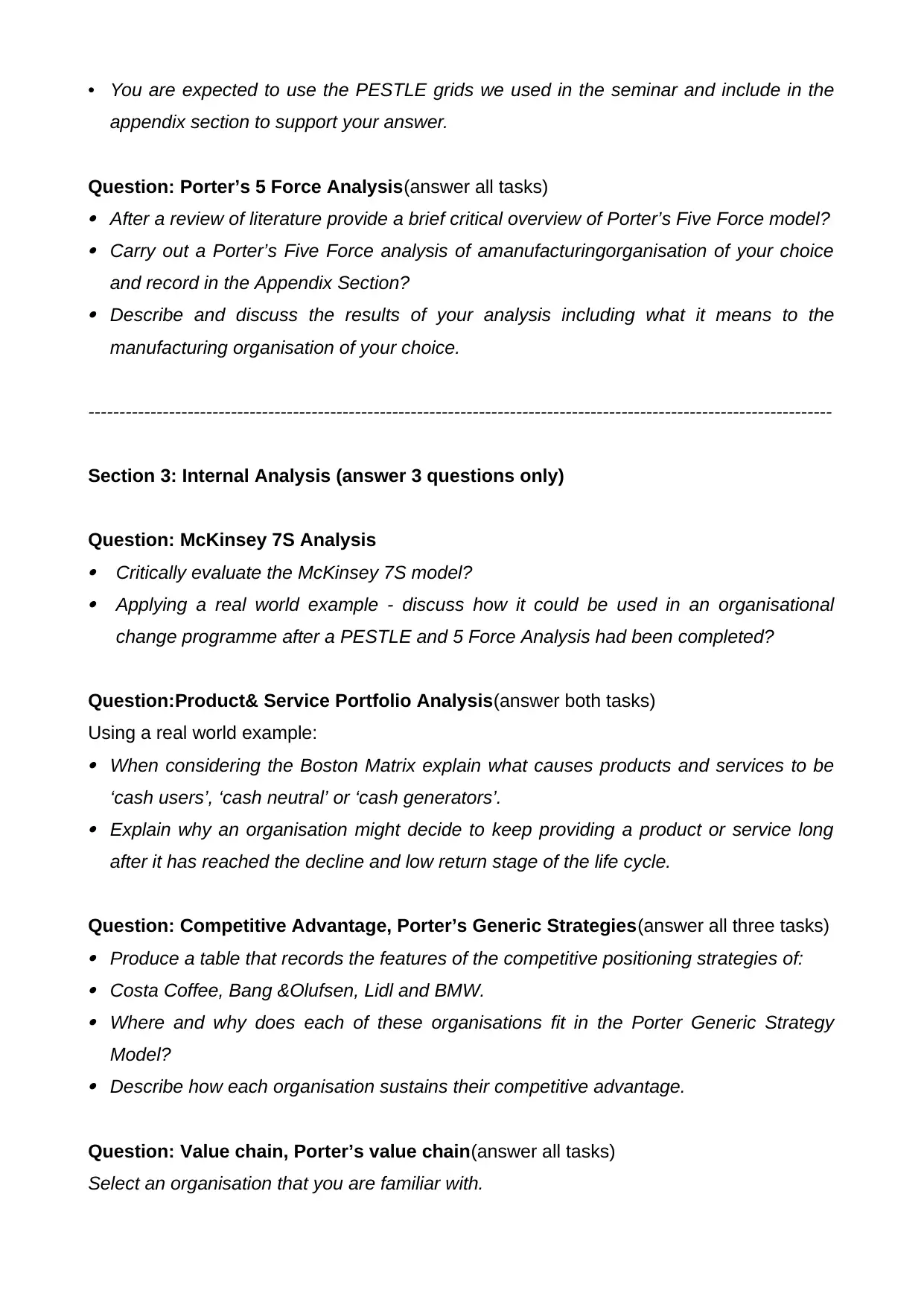
• You are expected to use the PESTLE grids we used in the seminar and include in the
appendix section to support your answer.
Question: Porter’s 5 Force Analysis(answer all tasks) After a review of literature provide a brief critical overview of Porter’s Five Force model? Carry out a Porter’s Five Force analysis of amanufacturingorganisation of your choice
and record in the Appendix Section? Describe and discuss the results of your analysis including what it means to the
manufacturing organisation of your choice.
------------------------------------------------------------------------------------------------------------------------
Section 3: Internal Analysis (answer 3 questions only)
Question: McKinsey 7S Analysis Critically evaluate the McKinsey 7S model? Applying a real world example - discuss how it could be used in an organisational
change programme after a PESTLE and 5 Force Analysis had been completed?
Question:Product& Service Portfolio Analysis(answer both tasks)
Using a real world example: When considering the Boston Matrix explain what causes products and services to be
‘cash users’, ‘cash neutral’ or ‘cash generators’. Explain why an organisation might decide to keep providing a product or service long
after it has reached the decline and low return stage of the life cycle.
Question: Competitive Advantage, Porter’s Generic Strategies(answer all three tasks) Produce a table that records the features of the competitive positioning strategies of: Costa Coffee, Bang &Olufsen, Lidl and BMW. Where and why does each of these organisations fit in the Porter Generic Strategy
Model? Describe how each organisation sustains their competitive advantage.
Question: Value chain, Porter’s value chain(answer all tasks)
Select an organisation that you are familiar with.
appendix section to support your answer.
Question: Porter’s 5 Force Analysis(answer all tasks) After a review of literature provide a brief critical overview of Porter’s Five Force model? Carry out a Porter’s Five Force analysis of amanufacturingorganisation of your choice
and record in the Appendix Section? Describe and discuss the results of your analysis including what it means to the
manufacturing organisation of your choice.
------------------------------------------------------------------------------------------------------------------------
Section 3: Internal Analysis (answer 3 questions only)
Question: McKinsey 7S Analysis Critically evaluate the McKinsey 7S model? Applying a real world example - discuss how it could be used in an organisational
change programme after a PESTLE and 5 Force Analysis had been completed?
Question:Product& Service Portfolio Analysis(answer both tasks)
Using a real world example: When considering the Boston Matrix explain what causes products and services to be
‘cash users’, ‘cash neutral’ or ‘cash generators’. Explain why an organisation might decide to keep providing a product or service long
after it has reached the decline and low return stage of the life cycle.
Question: Competitive Advantage, Porter’s Generic Strategies(answer all three tasks) Produce a table that records the features of the competitive positioning strategies of: Costa Coffee, Bang &Olufsen, Lidl and BMW. Where and why does each of these organisations fit in the Porter Generic Strategy
Model? Describe how each organisation sustains their competitive advantage.
Question: Value chain, Porter’s value chain(answer all tasks)
Select an organisation that you are familiar with.
Paraphrase This Document
Need a fresh take? Get an instant paraphrase of this document with our AI Paraphraser
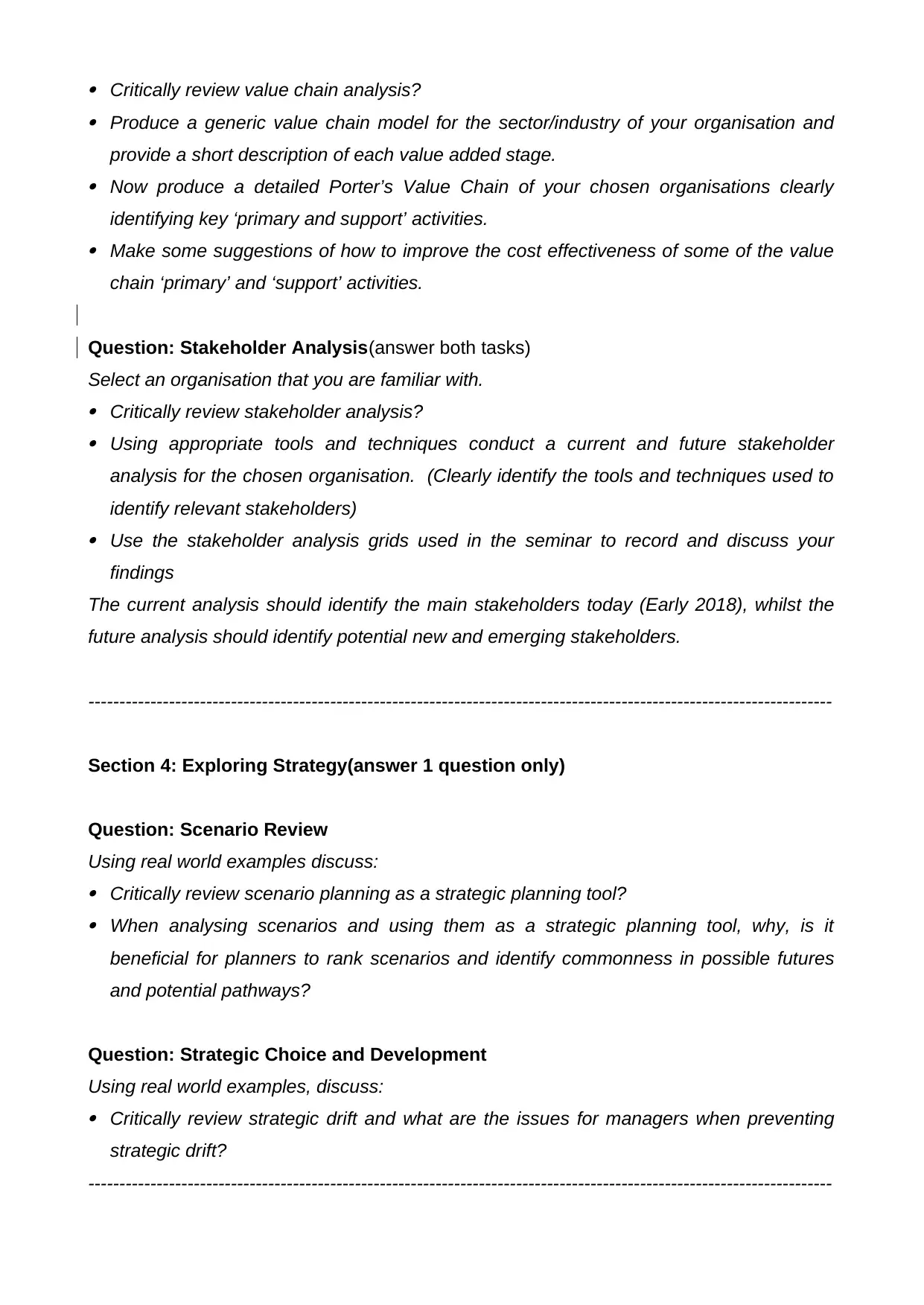
Critically review value chain analysis? Produce a generic value chain model for the sector/industry of your organisation and
provide a short description of each value added stage. Now produce a detailed Porter’s Value Chain of your chosen organisations clearly
identifying key ‘primary and support’ activities. Make some suggestions of how to improve the cost effectiveness of some of the value
chain ‘primary’ and ‘support’ activities.
Question: Stakeholder Analysis(answer both tasks)
Select an organisation that you are familiar with. Critically review stakeholder analysis? Using appropriate tools and techniques conduct a current and future stakeholder
analysis for the chosen organisation. (Clearly identify the tools and techniques used to
identify relevant stakeholders) Use the stakeholder analysis grids used in the seminar to record and discuss your
findings
The current analysis should identify the main stakeholders today (Early 2018), whilst the
future analysis should identify potential new and emerging stakeholders.
------------------------------------------------------------------------------------------------------------------------
Section 4: Exploring Strategy(answer 1 question only)
Question: Scenario Review
Using real world examples discuss: Critically review scenario planning as a strategic planning tool? When analysing scenarios and using them as a strategic planning tool, why, is it
beneficial for planners to rank scenarios and identify commonness in possible futures
and potential pathways?
Question: Strategic Choice and Development
Using real world examples, discuss: Critically review strategic drift and what are the issues for managers when preventing
strategic drift?
------------------------------------------------------------------------------------------------------------------------
provide a short description of each value added stage. Now produce a detailed Porter’s Value Chain of your chosen organisations clearly
identifying key ‘primary and support’ activities. Make some suggestions of how to improve the cost effectiveness of some of the value
chain ‘primary’ and ‘support’ activities.
Question: Stakeholder Analysis(answer both tasks)
Select an organisation that you are familiar with. Critically review stakeholder analysis? Using appropriate tools and techniques conduct a current and future stakeholder
analysis for the chosen organisation. (Clearly identify the tools and techniques used to
identify relevant stakeholders) Use the stakeholder analysis grids used in the seminar to record and discuss your
findings
The current analysis should identify the main stakeholders today (Early 2018), whilst the
future analysis should identify potential new and emerging stakeholders.
------------------------------------------------------------------------------------------------------------------------
Section 4: Exploring Strategy(answer 1 question only)
Question: Scenario Review
Using real world examples discuss: Critically review scenario planning as a strategic planning tool? When analysing scenarios and using them as a strategic planning tool, why, is it
beneficial for planners to rank scenarios and identify commonness in possible futures
and potential pathways?
Question: Strategic Choice and Development
Using real world examples, discuss: Critically review strategic drift and what are the issues for managers when preventing
strategic drift?
------------------------------------------------------------------------------------------------------------------------
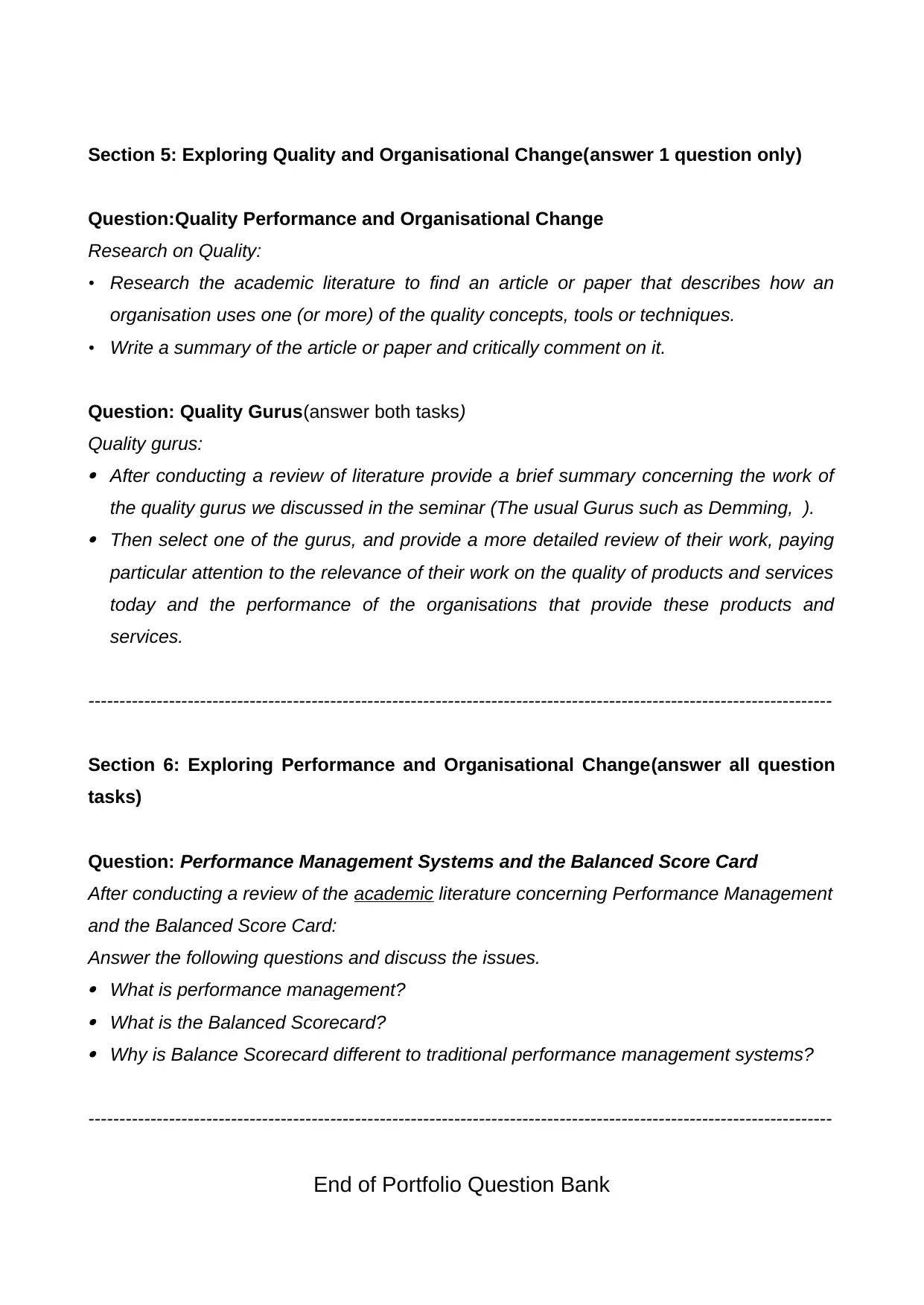
Section 5: Exploring Quality and Organisational Change(answer 1 question only)
Question:Quality Performance and Organisational Change
Research on Quality:
• Research the academic literature to find an article or paper that describes how an
organisation uses one (or more) of the quality concepts, tools or techniques.
• Write a summary of the article or paper and critically comment on it.
Question: Quality Gurus(answer both tasks)
Quality gurus: After conducting a review of literature provide a brief summary concerning the work of
the quality gurus we discussed in the seminar (The usual Gurus such as Demming, ). Then select one of the gurus, and provide a more detailed review of their work, paying
particular attention to the relevance of their work on the quality of products and services
today and the performance of the organisations that provide these products and
services.
------------------------------------------------------------------------------------------------------------------------
Section 6: Exploring Performance and Organisational Change(answer all question
tasks)
Question: Performance Management Systems and the Balanced Score Card
After conducting a review of the academic literature concerning Performance Management
and the Balanced Score Card:
Answer the following questions and discuss the issues. What is performance management? What is the Balanced Scorecard? Why is Balance Scorecard different to traditional performance management systems?
------------------------------------------------------------------------------------------------------------------------
End of Portfolio Question Bank
Question:Quality Performance and Organisational Change
Research on Quality:
• Research the academic literature to find an article or paper that describes how an
organisation uses one (or more) of the quality concepts, tools or techniques.
• Write a summary of the article or paper and critically comment on it.
Question: Quality Gurus(answer both tasks)
Quality gurus: After conducting a review of literature provide a brief summary concerning the work of
the quality gurus we discussed in the seminar (The usual Gurus such as Demming, ). Then select one of the gurus, and provide a more detailed review of their work, paying
particular attention to the relevance of their work on the quality of products and services
today and the performance of the organisations that provide these products and
services.
------------------------------------------------------------------------------------------------------------------------
Section 6: Exploring Performance and Organisational Change(answer all question
tasks)
Question: Performance Management Systems and the Balanced Score Card
After conducting a review of the academic literature concerning Performance Management
and the Balanced Score Card:
Answer the following questions and discuss the issues. What is performance management? What is the Balanced Scorecard? Why is Balance Scorecard different to traditional performance management systems?
------------------------------------------------------------------------------------------------------------------------
End of Portfolio Question Bank
⊘ This is a preview!⊘
Do you want full access?
Subscribe today to unlock all pages.

Trusted by 1+ million students worldwide

Paraphrase This Document
Need a fresh take? Get an instant paraphrase of this document with our AI Paraphraser
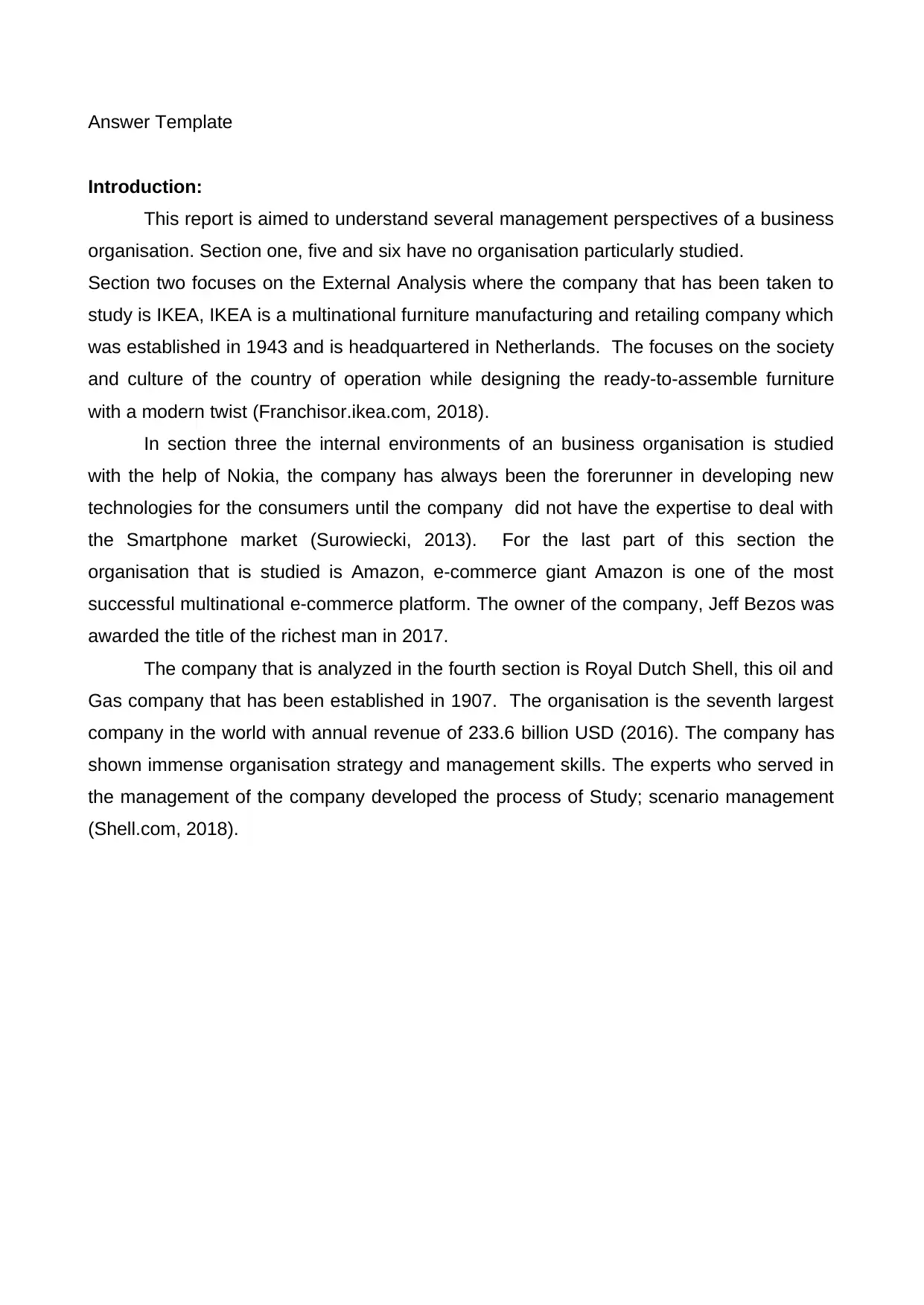
Answer Template
Introduction:
This report is aimed to understand several management perspectives of a business
organisation. Section one, five and six have no organisation particularly studied.
Section two focuses on the External Analysis where the company that has been taken to
study is IKEA, IKEA is a multinational furniture manufacturing and retailing company which
was established in 1943 and is headquartered in Netherlands. The focuses on the society
and culture of the country of operation while designing the ready-to-assemble furniture
with a modern twist (Franchisor.ikea.com, 2018).
In section three the internal environments of an business organisation is studied
with the help of Nokia, the company has always been the forerunner in developing new
technologies for the consumers until the company did not have the expertise to deal with
the Smartphone market (Surowiecki, 2013). For the last part of this section the
organisation that is studied is Amazon, e-commerce giant Amazon is one of the most
successful multinational e-commerce platform. The owner of the company, Jeff Bezos was
awarded the title of the richest man in 2017.
The company that is analyzed in the fourth section is Royal Dutch Shell, this oil and
Gas company that has been established in 1907. The organisation is the seventh largest
company in the world with annual revenue of 233.6 billion USD (2016). The company has
shown immense organisation strategy and management skills. The experts who served in
the management of the company developed the process of Study; scenario management
(Shell.com, 2018).
Introduction:
This report is aimed to understand several management perspectives of a business
organisation. Section one, five and six have no organisation particularly studied.
Section two focuses on the External Analysis where the company that has been taken to
study is IKEA, IKEA is a multinational furniture manufacturing and retailing company which
was established in 1943 and is headquartered in Netherlands. The focuses on the society
and culture of the country of operation while designing the ready-to-assemble furniture
with a modern twist (Franchisor.ikea.com, 2018).
In section three the internal environments of an business organisation is studied
with the help of Nokia, the company has always been the forerunner in developing new
technologies for the consumers until the company did not have the expertise to deal with
the Smartphone market (Surowiecki, 2013). For the last part of this section the
organisation that is studied is Amazon, e-commerce giant Amazon is one of the most
successful multinational e-commerce platform. The owner of the company, Jeff Bezos was
awarded the title of the richest man in 2017.
The company that is analyzed in the fourth section is Royal Dutch Shell, this oil and
Gas company that has been established in 1907. The organisation is the seventh largest
company in the world with annual revenue of 233.6 billion USD (2016). The company has
shown immense organisation strategy and management skills. The experts who served in
the management of the company developed the process of Study; scenario management
(Shell.com, 2018).
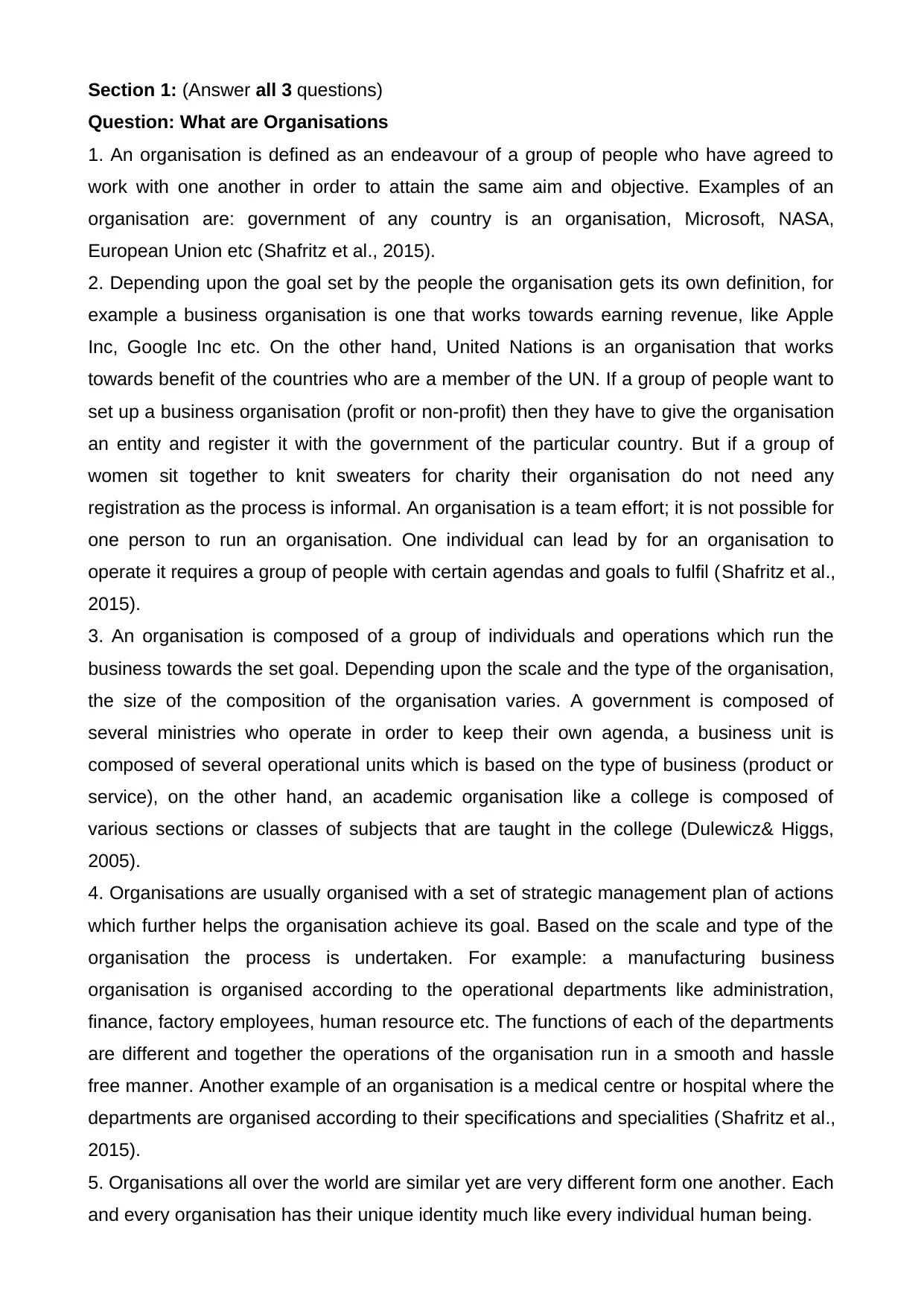
Section 1: (Answer all 3 questions)
Question: What are Organisations
1. An organisation is defined as an endeavour of a group of people who have agreed to
work with one another in order to attain the same aim and objective. Examples of an
organisation are: government of any country is an organisation, Microsoft, NASA,
European Union etc (Shafritz et al., 2015).
2. Depending upon the goal set by the people the organisation gets its own definition, for
example a business organisation is one that works towards earning revenue, like Apple
Inc, Google Inc etc. On the other hand, United Nations is an organisation that works
towards benefit of the countries who are a member of the UN. If a group of people want to
set up a business organisation (profit or non-profit) then they have to give the organisation
an entity and register it with the government of the particular country. But if a group of
women sit together to knit sweaters for charity their organisation do not need any
registration as the process is informal. An organisation is a team effort; it is not possible for
one person to run an organisation. One individual can lead by for an organisation to
operate it requires a group of people with certain agendas and goals to fulfil (Shafritz et al.,
2015).
3. An organisation is composed of a group of individuals and operations which run the
business towards the set goal. Depending upon the scale and the type of the organisation,
the size of the composition of the organisation varies. A government is composed of
several ministries who operate in order to keep their own agenda, a business unit is
composed of several operational units which is based on the type of business (product or
service), on the other hand, an academic organisation like a college is composed of
various sections or classes of subjects that are taught in the college (Dulewicz& Higgs,
2005).
4. Organisations are usually organised with a set of strategic management plan of actions
which further helps the organisation achieve its goal. Based on the scale and type of the
organisation the process is undertaken. For example: a manufacturing business
organisation is organised according to the operational departments like administration,
finance, factory employees, human resource etc. The functions of each of the departments
are different and together the operations of the organisation run in a smooth and hassle
free manner. Another example of an organisation is a medical centre or hospital where the
departments are organised according to their specifications and specialities (Shafritz et al.,
2015).
5. Organisations all over the world are similar yet are very different form one another. Each
and every organisation has their unique identity much like every individual human being.
Question: What are Organisations
1. An organisation is defined as an endeavour of a group of people who have agreed to
work with one another in order to attain the same aim and objective. Examples of an
organisation are: government of any country is an organisation, Microsoft, NASA,
European Union etc (Shafritz et al., 2015).
2. Depending upon the goal set by the people the organisation gets its own definition, for
example a business organisation is one that works towards earning revenue, like Apple
Inc, Google Inc etc. On the other hand, United Nations is an organisation that works
towards benefit of the countries who are a member of the UN. If a group of people want to
set up a business organisation (profit or non-profit) then they have to give the organisation
an entity and register it with the government of the particular country. But if a group of
women sit together to knit sweaters for charity their organisation do not need any
registration as the process is informal. An organisation is a team effort; it is not possible for
one person to run an organisation. One individual can lead by for an organisation to
operate it requires a group of people with certain agendas and goals to fulfil (Shafritz et al.,
2015).
3. An organisation is composed of a group of individuals and operations which run the
business towards the set goal. Depending upon the scale and the type of the organisation,
the size of the composition of the organisation varies. A government is composed of
several ministries who operate in order to keep their own agenda, a business unit is
composed of several operational units which is based on the type of business (product or
service), on the other hand, an academic organisation like a college is composed of
various sections or classes of subjects that are taught in the college (Dulewicz& Higgs,
2005).
4. Organisations are usually organised with a set of strategic management plan of actions
which further helps the organisation achieve its goal. Based on the scale and type of the
organisation the process is undertaken. For example: a manufacturing business
organisation is organised according to the operational departments like administration,
finance, factory employees, human resource etc. The functions of each of the departments
are different and together the operations of the organisation run in a smooth and hassle
free manner. Another example of an organisation is a medical centre or hospital where the
departments are organised according to their specifications and specialities (Shafritz et al.,
2015).
5. Organisations all over the world are similar yet are very different form one another. Each
and every organisation has their unique identity much like every individual human being.
⊘ This is a preview!⊘
Do you want full access?
Subscribe today to unlock all pages.

Trusted by 1+ million students worldwide
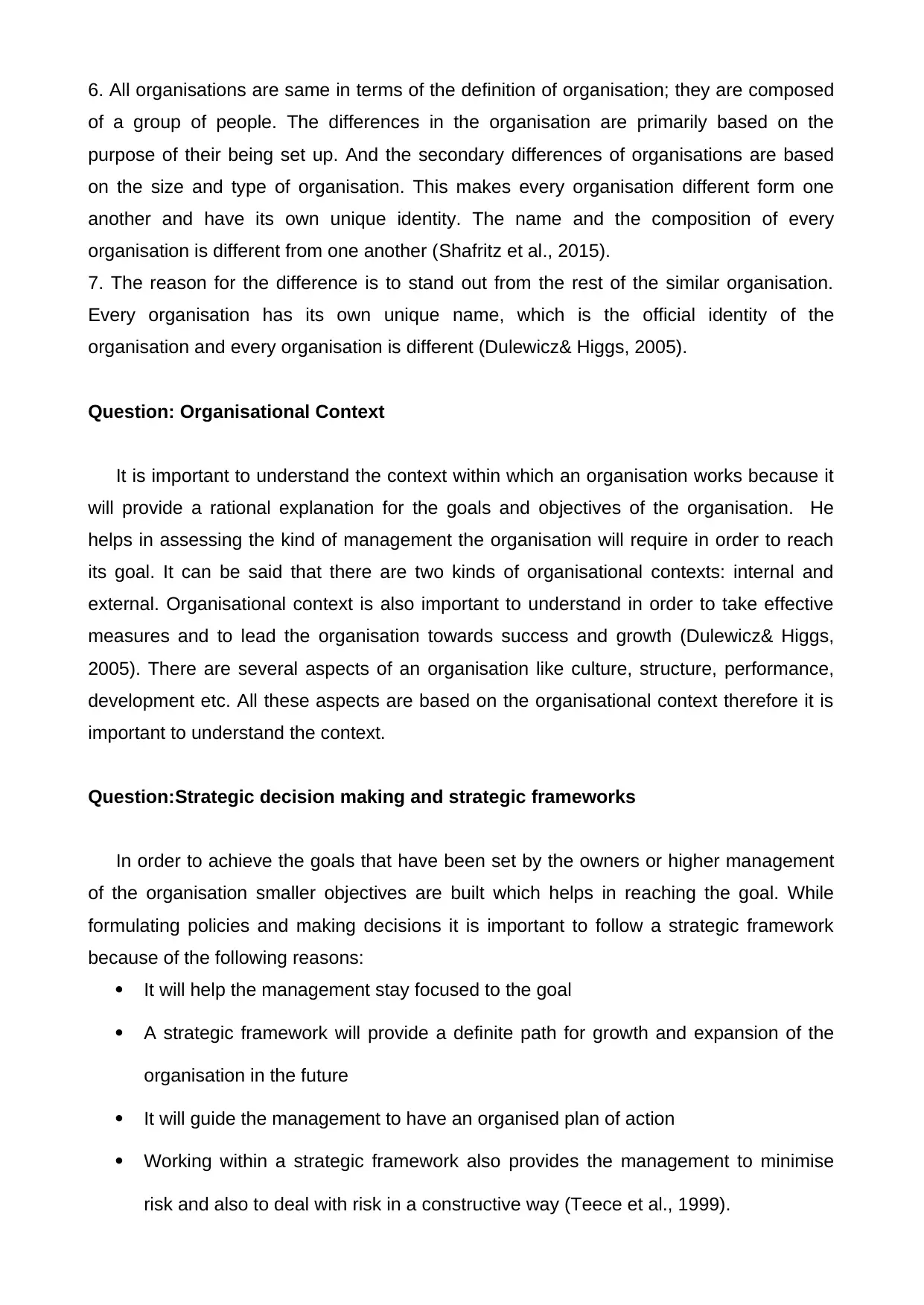
6. All organisations are same in terms of the definition of organisation; they are composed
of a group of people. The differences in the organisation are primarily based on the
purpose of their being set up. And the secondary differences of organisations are based
on the size and type of organisation. This makes every organisation different form one
another and have its own unique identity. The name and the composition of every
organisation is different from one another (Shafritz et al., 2015).
7. The reason for the difference is to stand out from the rest of the similar organisation.
Every organisation has its own unique name, which is the official identity of the
organisation and every organisation is different (Dulewicz& Higgs, 2005).
Question: Organisational Context
It is important to understand the context within which an organisation works because it
will provide a rational explanation for the goals and objectives of the organisation. He
helps in assessing the kind of management the organisation will require in order to reach
its goal. It can be said that there are two kinds of organisational contexts: internal and
external. Organisational context is also important to understand in order to take effective
measures and to lead the organisation towards success and growth (Dulewicz& Higgs,
2005). There are several aspects of an organisation like culture, structure, performance,
development etc. All these aspects are based on the organisational context therefore it is
important to understand the context.
Question:Strategic decision making and strategic frameworks
In order to achieve the goals that have been set by the owners or higher management
of the organisation smaller objectives are built which helps in reaching the goal. While
formulating policies and making decisions it is important to follow a strategic framework
because of the following reasons:
It will help the management stay focused to the goal
A strategic framework will provide a definite path for growth and expansion of the
organisation in the future
It will guide the management to have an organised plan of action
Working within a strategic framework also provides the management to minimise
risk and also to deal with risk in a constructive way (Teece et al., 1999).
of a group of people. The differences in the organisation are primarily based on the
purpose of their being set up. And the secondary differences of organisations are based
on the size and type of organisation. This makes every organisation different form one
another and have its own unique identity. The name and the composition of every
organisation is different from one another (Shafritz et al., 2015).
7. The reason for the difference is to stand out from the rest of the similar organisation.
Every organisation has its own unique name, which is the official identity of the
organisation and every organisation is different (Dulewicz& Higgs, 2005).
Question: Organisational Context
It is important to understand the context within which an organisation works because it
will provide a rational explanation for the goals and objectives of the organisation. He
helps in assessing the kind of management the organisation will require in order to reach
its goal. It can be said that there are two kinds of organisational contexts: internal and
external. Organisational context is also important to understand in order to take effective
measures and to lead the organisation towards success and growth (Dulewicz& Higgs,
2005). There are several aspects of an organisation like culture, structure, performance,
development etc. All these aspects are based on the organisational context therefore it is
important to understand the context.
Question:Strategic decision making and strategic frameworks
In order to achieve the goals that have been set by the owners or higher management
of the organisation smaller objectives are built which helps in reaching the goal. While
formulating policies and making decisions it is important to follow a strategic framework
because of the following reasons:
It will help the management stay focused to the goal
A strategic framework will provide a definite path for growth and expansion of the
organisation in the future
It will guide the management to have an organised plan of action
Working within a strategic framework also provides the management to minimise
risk and also to deal with risk in a constructive way (Teece et al., 1999).
Paraphrase This Document
Need a fresh take? Get an instant paraphrase of this document with our AI Paraphraser
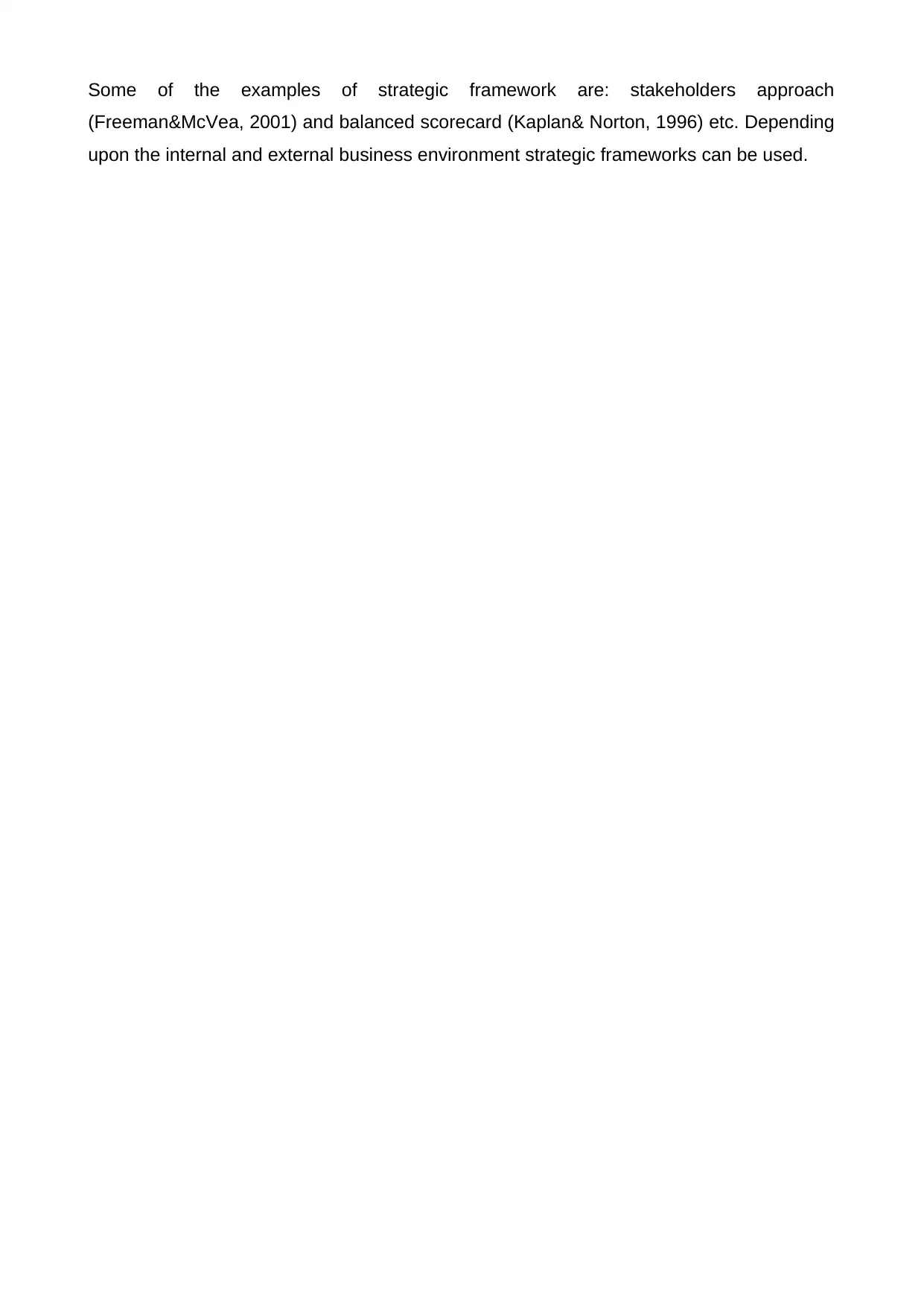
Some of the examples of strategic framework are: stakeholders approach
(Freeman&McVea, 2001) and balanced scorecard (Kaplan& Norton, 1996) etc. Depending
upon the internal and external business environment strategic frameworks can be used.
(Freeman&McVea, 2001) and balanced scorecard (Kaplan& Norton, 1996) etc. Depending
upon the internal and external business environment strategic frameworks can be used.
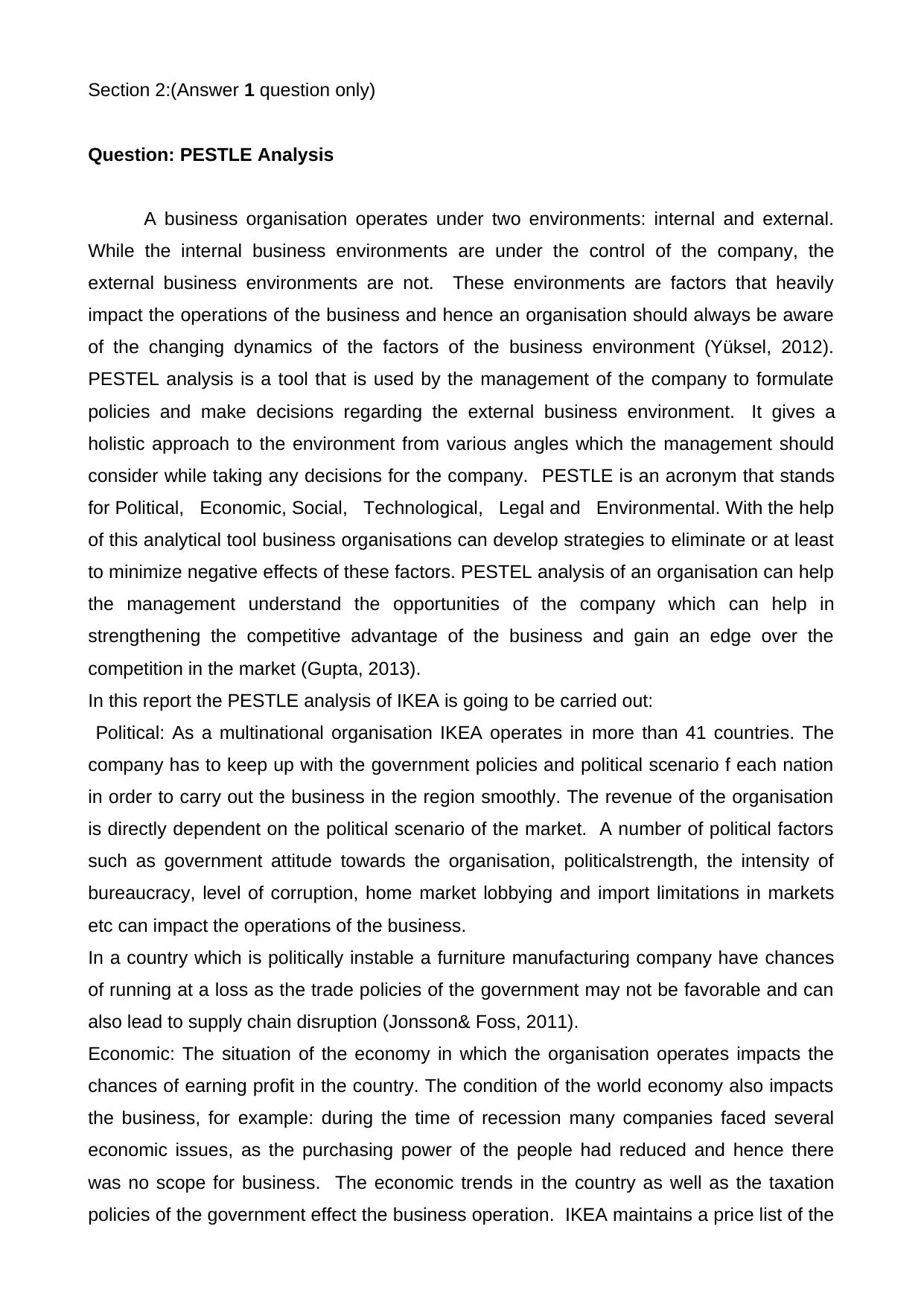
Section 2:(Answer 1 question only)
Question: PESTLE Analysis
A business organisation operates under two environments: internal and external.
While the internal business environments are under the control of the company, the
external business environments are not. These environments are factors that heavily
impact the operations of the business and hence an organisation should always be aware
of the changing dynamics of the factors of the business environment (Yüksel, 2012).
PESTEL analysis is a tool that is used by the management of the company to formulate
policies and make decisions regarding the external business environment. It gives a
holistic approach to the environment from various angles which the management should
consider while taking any decisions for the company. PESTLE is an acronym that stands
for Political, Economic, Social, Technological, Legal and Environmental. With the help
of this analytical tool business organisations can develop strategies to eliminate or at least
to minimize negative effects of these factors. PESTEL analysis of an organisation can help
the management understand the opportunities of the company which can help in
strengthening the competitive advantage of the business and gain an edge over the
competition in the market (Gupta, 2013).
In this report the PESTLE analysis of IKEA is going to be carried out:
Political: As a multinational organisation IKEA operates in more than 41 countries. The
company has to keep up with the government policies and political scenario f each nation
in order to carry out the business in the region smoothly. The revenue of the organisation
is directly dependent on the political scenario of the market. A number of political factors
such as government attitude towards the organisation, politicalstrength, the intensity of
bureaucracy, level of corruption, home market lobbying and import limitations in markets
etc can impact the operations of the business.
In a country which is politically instable a furniture manufacturing company have chances
of running at a loss as the trade policies of the government may not be favorable and can
also lead to supply chain disruption (Jonsson& Foss, 2011).
Economic: The situation of the economy in which the organisation operates impacts the
chances of earning profit in the country. The condition of the world economy also impacts
the business, for example: during the time of recession many companies faced several
economic issues, as the purchasing power of the people had reduced and hence there
was no scope for business. The economic trends in the country as well as the taxation
policies of the government effect the business operation. IKEA maintains a price list of the
Question: PESTLE Analysis
A business organisation operates under two environments: internal and external.
While the internal business environments are under the control of the company, the
external business environments are not. These environments are factors that heavily
impact the operations of the business and hence an organisation should always be aware
of the changing dynamics of the factors of the business environment (Yüksel, 2012).
PESTEL analysis is a tool that is used by the management of the company to formulate
policies and make decisions regarding the external business environment. It gives a
holistic approach to the environment from various angles which the management should
consider while taking any decisions for the company. PESTLE is an acronym that stands
for Political, Economic, Social, Technological, Legal and Environmental. With the help
of this analytical tool business organisations can develop strategies to eliminate or at least
to minimize negative effects of these factors. PESTEL analysis of an organisation can help
the management understand the opportunities of the company which can help in
strengthening the competitive advantage of the business and gain an edge over the
competition in the market (Gupta, 2013).
In this report the PESTLE analysis of IKEA is going to be carried out:
Political: As a multinational organisation IKEA operates in more than 41 countries. The
company has to keep up with the government policies and political scenario f each nation
in order to carry out the business in the region smoothly. The revenue of the organisation
is directly dependent on the political scenario of the market. A number of political factors
such as government attitude towards the organisation, politicalstrength, the intensity of
bureaucracy, level of corruption, home market lobbying and import limitations in markets
etc can impact the operations of the business.
In a country which is politically instable a furniture manufacturing company have chances
of running at a loss as the trade policies of the government may not be favorable and can
also lead to supply chain disruption (Jonsson& Foss, 2011).
Economic: The situation of the economy in which the organisation operates impacts the
chances of earning profit in the country. The condition of the world economy also impacts
the business, for example: during the time of recession many companies faced several
economic issues, as the purchasing power of the people had reduced and hence there
was no scope for business. The economic trends in the country as well as the taxation
policies of the government effect the business operation. IKEA maintains a price list of the
⊘ This is a preview!⊘
Do you want full access?
Subscribe today to unlock all pages.

Trusted by 1+ million students worldwide
1 out of 38
Related Documents
Your All-in-One AI-Powered Toolkit for Academic Success.
+13062052269
info@desklib.com
Available 24*7 on WhatsApp / Email
![[object Object]](/_next/static/media/star-bottom.7253800d.svg)
Unlock your academic potential
Copyright © 2020–2025 A2Z Services. All Rights Reserved. Developed and managed by ZUCOL.





